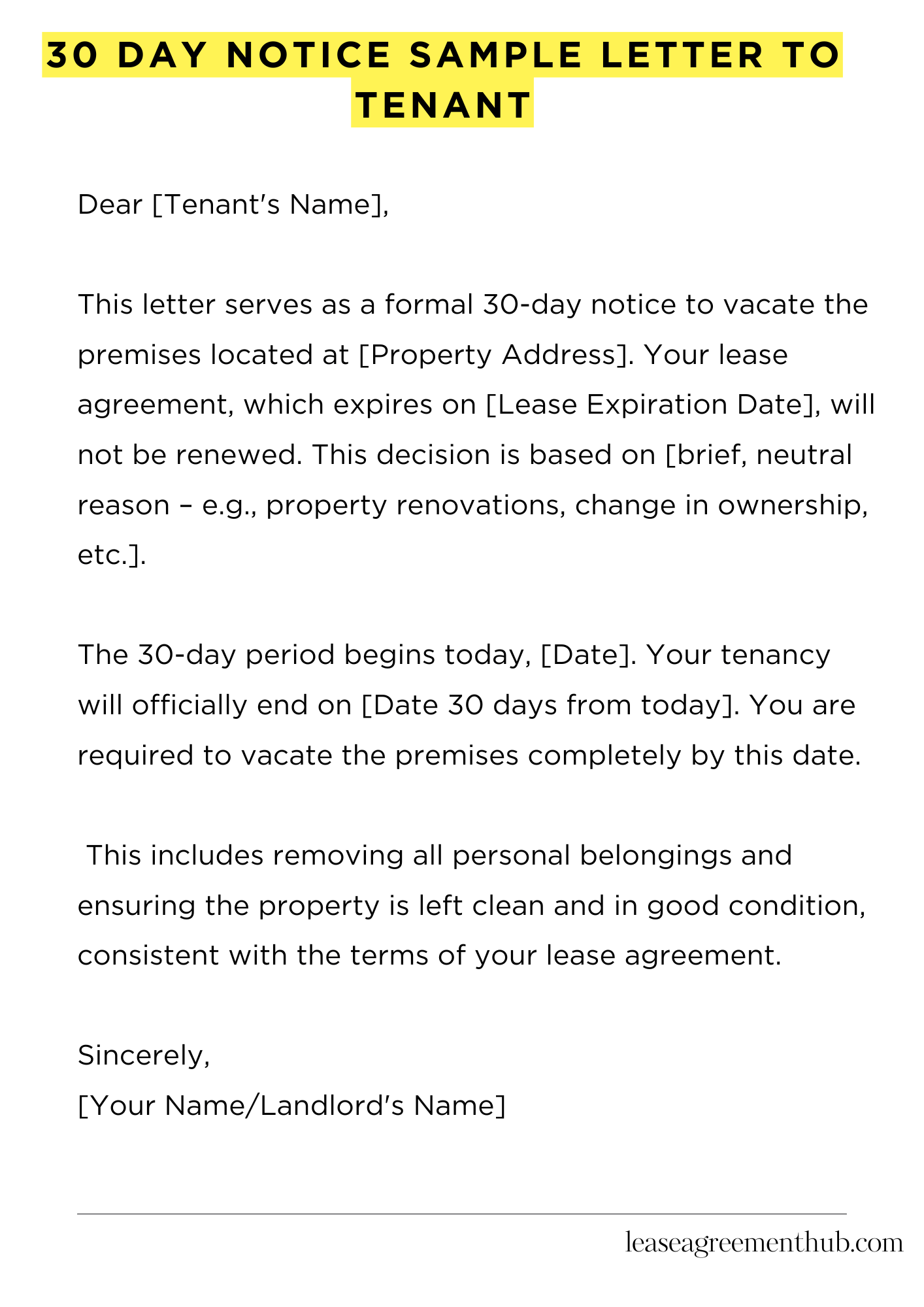A 30-day notice to a tenant is a formal letter. It tells the tenant they must move out within 30 days. This is usually required by law.
This article gives you examples of these letters. We provide templates. They make writing your own notice easy.
Use our samples. Save time and avoid mistakes. Get your notice written correctly.
30 Day Notice Sample Letter to Tenant
[Your Name/Landlord’s Name]
[Your Address]
[Your Phone Number]
[Your Email Address]
[Date]
[Tenant’s Name]
[Tenant’s Address]
Dear [Tenant’s Name],
This letter serves as a formal 30-day notice to vacate the premises located at [Property Address]. Your lease agreement, which expires on [Lease Expiration Date], will not be renewed. This decision is based on [brief, neutral reason – e.g., property renovations, change in ownership, etc.].
The 30-day period begins today, [Date]. Your tenancy will officially end on [Date 30 days from today]. You are required to vacate the premises completely by this date. This includes removing all personal belongings and ensuring the property is left clean and in good condition, consistent with the terms of your lease agreement.
Failure to vacate the premises by the specified date may result in legal action to recover possession of the property, and you may be held responsible for any additional costs incurred. Please contact me if you have any questions. We appreciate your time and cooperation during this process.
Sincerely,
[Your Name/Landlord’s Name]

How to Write a 30-Day Notice Sample Letter to Tenant
Understanding the Nuances of Eviction Notices
Eviction is a complex legal process. A poorly written notice can invalidate the entire procedure, leading to costly legal battles. Therefore, precision and adherence to local laws are paramount. This necessitates a meticulous approach to crafting your 30-day notice.
Defining the Purpose: Why a 30-Day Notice?
A 30-day notice to vacate serves as a formal declaration of the tenant’s lease termination. This is typically used for month-to-month tenancies, offering the tenant adequate time to find alternative accommodation. It’s crucial to differentiate this from notices for lease violations, which often carry different timelines and legal requirements. Failure to provide sufficient notice can expose you to legal repercussions.
Essential Components of a Legally Sound Notice
Your notice must unequivocally state the tenant’s obligation to vacate. Include the property address, the tenant’s name(s), and the precise date the tenancy terminates. Specify the reason for the termination (e.g., non-renewal of a month-to-month lease), and clearly state the tenant’s responsibility to leave the premises in a broom-swept condition, as stipulated in the lease agreement. Ambiguity invites legal challenges.
Crafting Your 30-Day Notice Sample Letter
Begin with a formal salutation. Use precise language, avoiding colloquialisms or ambiguities. Maintain a professional and dispassionate tone. Consider using a certified mail service with return receipt requested to ensure verifiable proof of delivery – a crucial element in any potential legal dispute. Subsequently, you should detail the move-out date explicitly. This serves as irrefutable evidence.
Sample 30-Day Notice Letter: A Practical Example
[Your Name/Landlord’s Name]
[Your Address]
[Your Phone Number]
[Your Email Address]
[Date]
[Tenant’s Name]
[Tenant’s Address]
NOTICE TO VACATE
This letter serves as formal notification that your month-to-month tenancy at [Property Address] is terminated, effective [Date – 30 days from the date of the letter]. You are required to vacate the premises on or before this date. Please ensure the property is left clean and in good condition, per the terms of your lease agreement. Failure to comply may result in further legal action.
Sincerely,
[Your Name/Landlord’s Name]
Legal Considerations and Local Ordinances
State and local laws governing evictions vary considerably. Consult with a legal professional or utilize readily available resources to ensure your notice complies with all applicable regulations. Ignoring these legal niceties can lead to protracted and expensive legal battles. Proactive legal counsel is a worthwhile investment.
Avoiding Common Pitfalls in Notice Writing
Avoid using threatening or inflammatory language. Maintain a strictly professional and factual tone. Ensure the date is clearly legible and accurate. Always retain a copy of the notice for your records. Finally, understand that a 30-day notice is not a panacea for all tenant issues; it addresses only month-to-month situations; other situations require different approaches.
FAQs about 30 Day Notice Sample Letter to Tenant
What is a 30-day notice to vacate letter, and when is it used?
A 30-day notice to vacate letter is a formal notification given by a landlord to a tenant, informing them that their tenancy will be terminated after 30 days. It’s typically used for month-to-month tenancies or in situations where a lease agreement allows for termination with 30 days’ notice.
What information should be included in a 30-day notice to vacate letter?
The letter should clearly state the intent to terminate the tenancy, the date the tenancy will end (30 days from the date of the letter), the tenant’s name and address, the property address, and the landlord’s signature. It’s also advisable to include the reason for the termination, if applicable, and any relevant legal references.
Where can I find a sample 30-day notice to vacate letter?
Numerous sample letters are available online through legal websites, real estate resources, and template providers. However, it’s crucial to adapt any sample to your specific circumstances and local laws.
Are there any specific legal requirements for a 30-day notice to vacate letter?
Legal requirements vary by jurisdiction. State and local laws dictate the proper format, required content, and method of delivery. It’s essential to consult local laws or legal counsel to ensure compliance.
What happens if a tenant doesn’t vacate the property after receiving a 30-day notice?
Failure to vacate after receiving a properly served 30-day notice can lead to legal action by the landlord, potentially involving eviction proceedings. The landlord should follow the proper legal channels for eviction in their jurisdiction.
Related: